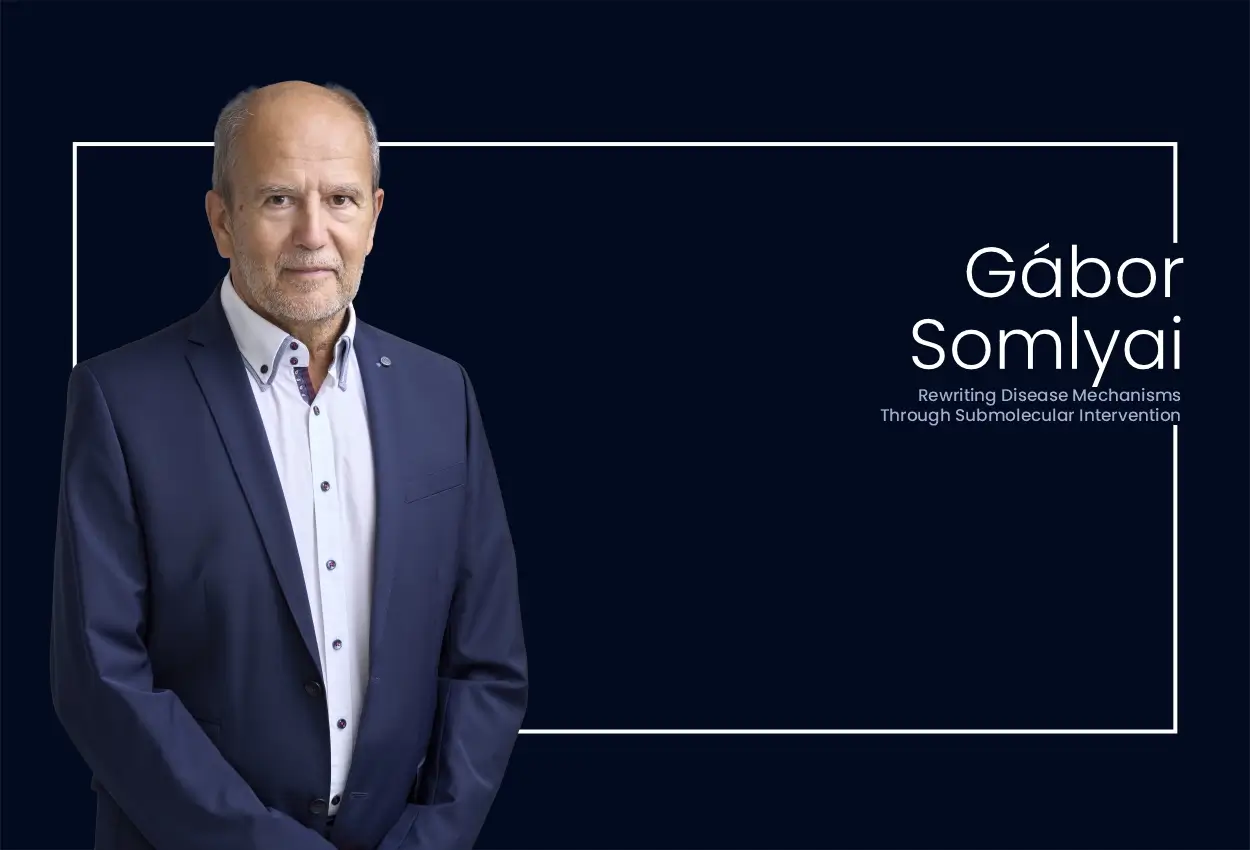Modern medicine has mapped the genome, decoded proteins, and developed precision therapies that were once unimaginable. Yet despite these advances, chronic diseases like cancer, diabetes, and age-related conditions continue to overwhelm lives, systems, and science. They often begin quietly, deep within the cell, far beneath the reach of most current treatments. What if the key to transforming these outcomes lies even smaller than our genes? What if the real switch that controls life and death in our cells is hidden within the most basic element of all: hydrogen?
Gábor Somlyai stepped into this microscopic mystery with a question that challenged decades of biological assumptions. His pioneering research into the role of hydrogen isotopes, particularly deuterium, opened a new dimension in cellular biology.
A New Blueprint for Life and Cancer Control
Dr. Somlyai explains that after decades of cancer research, scientists have successfully mapped a highly complex molecular signalling network responsible for initiating and completing cell division. Yet two fundamental questions remained: What triggers a cell to leave its resting state and begin DNA replication? And how is this intricate cascade of events precisely coordinated to produce two genetically identical daughter cells?
Dr. Somlyai’s groundbreaking work introduces a paradigm-shifting idea: cell division may be governed not only by genetic and protein-level interactions, but also by a submolecular mechanism linked to the atomic composition of hydrogen in the body. Specifically, he and his team identified the ratio between two naturally occurring hydrogen isotopes—protium and the heavier deuterium- as a direct influence on cellular behavior.
His research, dating back to 1990, demonstrated that lowering deuterium concentrations below natural levels inhibits tumor growth, while elevated levels stimulate cell proliferation. Over time, the data revealed that an increased deuterium-to-hydrogen (D/H) ratio serves as a biological trigger, initiating the transition from a resting phase into DNA replication, and synchronizing the complex genetic activities that follow.
This discovery not only redefines how scientists understand cancer growth but also opens the door to entirely new therapeutic possibilities, ones that operate at a level below conventional genetic or molecular intervention.
Overcoming Scientific Hurdles
When Dr. Somlyai began his research career in this field at the National Institute of Oncology in Hungary, the concept of deuterium depletion was virtually unexplored. One of his first scientific hurdles was to produce deuterium-depleted water (DDW), which he managed through water electrolysis, conducted in his own garage.
The next challenge was to measure deuterium levels with the necessary accuracy. For this, Dr. Somlyai collaborated with chemists Gábor Jancsó and György Jákli from the Central Research Institute for Physics, who possessed a reliable measurement technique.
The early experiments with DDW yielded remarkable anticancer effects. However, Dr. Somlyai and his team exercised scientific caution, repeating experiments for over a year to eliminate any possibility of error. Confident in the consistency of the findings, Dr. Somlyai reached out to other research institutions and universities to replicate and explore the effects of changing the D/H ratio in various biological systems.
The results were consistent: across multiple models, reducing deuterium levels significantly impacted cell behavior and confirmed the isotope’s regulatory role in physiological processes. This collaborative effort helped establish a solid scientific foundation for what would grow into a revolutionary approach to cancer treatment.
Thirty-five Years of Defying Convention and Defining the Future
Since the early 1990s, HYD LLC has remained a global pioneer in deuterium depletion research and application. Dr. Somlyai credits the company’s longevity to its willingness to challenge conventional scientific thinking, along with a relentless commitment to innovation.
In 1999, HYD LLC made history by registering Vetera-DDW-25, the first deuterium-depleted, water-based anticancer drug for veterinary use. That same year, the company launched Preventa, the world’s first commercially available deuterium-depleted drinking water. These products served both as a proof of concept and a means of funding continued research and drug development.
Dr. Somlyai believes the company’s continued leadership is partly due to the natural inertia of scientific systems. While the broader field still focuses on molecule-centered mechanisms, HYD has taken a bold step toward the submolecular level, representing a fundamental shift in perspective. Such shifts are rarely quick, but Dr. Somlyai has remained confident in the long-term value of this direction.
Today, that confidence is being validated. More researchers around the world are joining the field, and a growing number of manufacturers are now producing DDW. This momentum is driving the scientific community toward broader acceptance and application of deuterium depletion in medicine.
With over thirty-five years of accumulated research and clinical experience, HYD LLC continues to lead the field. But for Dr. Somlyai, leadership does not mean exclusivity. His book, Deuterium Depletion – A New Way in Curing Cancer and Preserving Health, was written to share key discoveries and practical knowledge with the wider public. It serves both as a reflection of his life’s work and a forward-looking blueprint for the future of cancer treatment and preventive health.
Rewriting the Rules of Cell Division
Dr. Somlyai explains that modern anticancer drug development has gone through two major phases. Initially, the focus was on discovering compounds that could effectively kill cancer cells while minimizing harm to healthy tissue. Chemotherapy emerged as a powerful tool in this phase, improving survival rates but often at the cost of severe toxicity.
Later, a shift occurred with the discovery of molecular mechanisms that regulate cell division. This led to the development of targeted therapies, aimed at specific molecules within cell signaling pathways. While more refined, these therapies still operate at the molecular level. As a result, cancer incidence and mortality continue to rise, indicating that a deeper, more fundamental shift in approach is needed.
The breakthrough in Dr. Somlyai’s work comes from focusing on the submolecular level. Specifically, he highlights the role of the hydrogen–deuterium (D/H) isotope ratio in influencing the behavior of cells. Unlike traditional therapies that target single molecules or pathways, modifying the D/H ratio affects the entire network of genes and proteins that regulate cell division. Depleting deuterium from cells enables a simultaneous impact across all signaling pathways, offering a more comprehensive way to influence cell behavior. This approach has shown effectiveness across all tumor types, although sensitivity can vary.
A Natural and Safer Pathway
Dr. Somlyai contrasts deuterium depletion with conventional cancer treatments that rely on synthetic drugs, which often come with significant toxic side effects. In his view, the most straightforward way to reduce deuterium levels in the body is by substituting regular water with deuterium-depleted water, known as DDW.
This method does not involve introducing foreign chemicals into the body. Instead, it works by lowering the natural level of deuterium in biological systems. Over the past thirty years, thousands of patients have undergone deuterium depletion. Toxicological studies, both preclinical and clinical, have confirmed the safety of DDW at concentrations ranging from 20 to 125 parts per million. No harmful effects have been detected.
He also refers to the experience with a veterinary anticancer product containing DDW, developed and registered by HYD LLC in 1999. The product has demonstrated a strong safety profile, further reinforcing the potential of DDW-based treatments as a safe, non-toxic, and highly effective option for cancer therapy.
A Vision Beyond Patents
Discussing the challenges of intellectual property, Dr. Somlyai notes that HYD LLC held strong patent protections for more than twenty years. However, those original patents have now expired, and the scientific knowledge has entered the public domain. Still, he sees this not as a setback but as an opportunity. With current knowledge, new and patentable products can be developed. HYD LLC fully intends to pursue these opportunities, knowing that exclusive rights are often a deciding factor for investors.
At the same time, Dr. Somlyai voices concern that the pharmaceutical industry places too much emphasis on exclusivity. The growing global burden of cancer calls for solutions that prioritize health over monopolies. He finds it puzzling that faster, more affordable therapies are not the leading priority, especially when they could alleviate economic strain on healthcare systems.
HYD LLC is currently seeking financial investment and strategic partners to bring a cancer drug to market, even in the absence of active patents. With adequate funding, the company can advance research and apply for new patents, offering the protection that pharmaceutical investors typically expect. Yet, Dr. Somlyai’s ultimate goal remains clear: to accelerate the fight against cancer through bold science and collaborative progress.
A Rising Tide of Academic Collaboration
Dr. Somlyai highlights a significant development in the global recognition of deuterium depletion as a promising area of scientific research. The European Research Executive Agency (REA) of the European Commission recently awarded a grant of €763,600 to the Aqua-Synapse research program, launched in January 2023. This initiative explores the effects of deuterium-depleted water (DDW) on brain function and neuronal activity, with a particular focus on its potential relevance to depression, metabolic disorders, obesity, and aging.
HYD Cancer Research and Drug Development LLC. is an active member of this European consortium. The group includes leading academic institutions such as Lusófona University and the Institute of Molecular Medicine in Lisbon, the University Hospital of Würzburg, and the University of Oxford. According to Dr. Somlyai, such collaborations are not only accelerating scientific understanding but are also establishing credibility and validation for DDW research on a global scale.
He also points to the growing number of scientific publications in the PubMed database referencing deuterium-depleted water. Since the early 1990s, this number has increased exponentially, demonstrating that universities and research institutes worldwide are becoming increasingly engaged in the exploration of this novel field.
Building the Future of Oncology
When asked about industrial production, Dr. Somlyai explains that deuterium-depleted water can be produced reliably on a large scale using fractional distillation, allowing for control over deuterium content to extremely low levels. While the technology for production exists, the primary challenge has been meeting the stringent requirements of pharmaceutical-grade quality.
HYD LLC, together with its parent company HYD Pharma Inc., has overcome this challenge. They have established the world’s first pharmaceutical manufacturing facility capable of producing DDW as an active pharmaceutical ingredient under Good Manufacturing Practice (GMP) standards. This milestone enables the production of DDW suitable for clinical trials and ultimately, therapeutic use. For Dr. Somlyai and his team, this achievement not only represents technological innovation but also positions Hungary at the forefront of a new generation of cancer treatment strategies.
Approaching the Threshold of Clinical Integration
Dr. Somlyai confirms that HYD LLC is ready to initiate full-scale clinical trials for deuterium-depleted drugs. All essential elements are in place. The DDW manufacturing facility is operational, the clinical protocols and dosage plans have been developed, and the team has decades of experience in both research and veterinary applications. The only remaining step is securing the necessary capital investment for human clinical development.
He emphasizes the compelling results observed even in the most resistant tumor types, where DDW treatment has extended survival times to three times longer than those achieved with conventional therapies alone. These outcomes are not isolated incidents but are grounded in years of consistent evidence.
In their most recent publication, Dr. Somlyai and his team analyzed data from 2,649 cancer patients who consumed DDW. The study concluded that incorporating deuterium-depleted water into existing oncology protocols could potentially reduce cancer-related mortality by up to 80 percent. This finding underscores the transformative potential of deuterium depletion therapy and highlights the urgent need for further clinical exploration.
Expanding Therapeutic Horizons
Dr. Somlyai recalls his initial surprise when consumer feedback revealed that deuterium-depleted water (DDW) consumption appeared to reduce blood glucose levels in a diabetic patient. This unexpected observation led HYD LLC to collaborate with researchers at Semmelweis University in Budapest. Together, they conducted several animal studies, which confirmed that the deuterium-to-hydrogen (D/H) ratio also plays a critical role in metabolic regulation.
Encouraged by these results, the team proceeded with a Phase 2 human clinical trial. The study demonstrated that deuterium depletion not only reduced fasting blood glucose levels but also improved insulin resistance in patients. These findings suggest that the benefits of DDW extend far beyond oncology.
Dr. Somlyai also highlights other independent research initiatives. Some studies have linked the deuterium content of drinking water to susceptibility to depression. Animal experiments have shown that DDW has a positive effect on long-term memory, while HYD’s own investigations suggest that deuterium depletion may also contribute to anti-aging processes. These developments point to a much broader potential for DDW in preventive health and chronic disease management.
Maintaining Scientific Rigor Across Borders
As international interest in deuterium-depleted technology grows, Dr. Somlyai emphasizes that HYD LLC remains committed to the highest standards of scientific integrity and quality control. All of HYD’s DDW products, protected under international trademarks, are rigorously tested by accredited laboratories. The deuterium content is measured using a validated, laser-based water isotope analyzer, providing accuracy within 1 part per million.
The microbiological safety of the products is confirmed in pharmaceutical-grade laboratories, and every production batch is supported by traceable quality certificates. This strict adherence to documentation and testing reflects HYD’s dedication to transparency and product reliability.
Looking forward, the company is preparing for pharmaceutical-grade production. The necessary infrastructure already complies with Good Manufacturing Practice (GMP) standards. HYD LLC is actively seeking regional partners worldwide who can support local clinical trials, establish manufacturing operations, and manage regulatory approvals. For Dr. Somlyai, these collaborations are crucial to making DDW therapy widely accessible and globally impactful.
Charting a New Course in Healthcare
Dr. Somlyai believes that drug development based on deuterium depletion marks the beginning of a new era in pharmaceutical science. He sees its influence extending across multiple medical disciplines, with the potential to revolutionize the treatment of chronic conditions such as cancer and metabolic disorders.
Despite its promise, Dr. Somlyai is careful not to portray DDW as a miracle cure. He acknowledges that ongoing research is essential to further refine its effectiveness. His long-term vision is ambitious yet grounded. He envisions a future in which cancer-related mortality can be reduced to just 10 to 15 percent of current levels. For him, this is not merely an aspiration but a scientifically achievable goal that could reshape the landscape of global healthcare.



